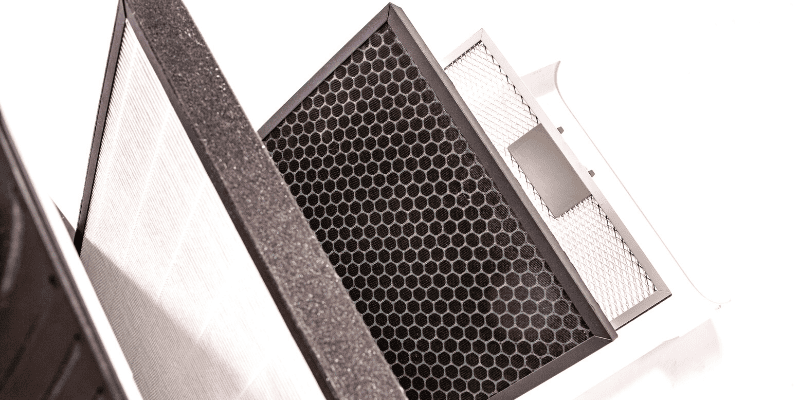When it comes time to making that big decision about what kind of air purifier you truly need inside of your home, there are many different questions and answers that you must know prior to this purchase. Each air purifier has several different components that will differ from other air purifiers, whether that be the size of the air purifier, how much square feet it covers in the environment, the type of technology that is used to filter the indoor air, how long the filters in this air device last, and even the cost to use this air purifier 24/7 inside of your home. The technology that is used in an air purifier is usually one of the most important features of an air purifier that will provide air filtration and pollutant removal of specific types of airborne pollution in a home.
Carbon (aka activated carbon, activated charcoal, etc.) is a well-known and popularly used air purifier technology that is integrated into air filters that are placed within these devices to filter the indoor air of a personal indoor environment. Carbon technology, in comparison to other revered air filtration technologies like ozone, ionizers, and HEPA filtration, works in a completely singular way to these other competitors. However, the question remains, is this the best air purifier technology to use in your home and what risks do you potentially face by using a carbon filter air purifier indoors?
In this article we are going to learn more about how a carbon filter air purifier works, the basis of how carbon technology operates inside of an air purifier and discuss other alternative air purifier technologies that may be a better option for your home or other personal indoor environments.
What is Activated Carbon Filter
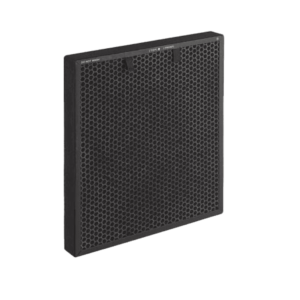 An activated carbon filter contains a form of carbon that has been processed to have an expansively large surface area with tiny, low-volume pores that help to provide the surface its ability to provide absorption or a chemical reaction on the carbon filter. The process undergone by the activated carbon or charcoal is a treatment of oxygen that allows the carbon to open up millions of tiny pores between the carbon atoms on the filter, according to Penn State University. This filtration method using activated carbon has become one of the most popular chemical absorption techniques for a wide range of filtration efforts including air filtration in air purifiers and HVAC filters.
An activated carbon filter contains a form of carbon that has been processed to have an expansively large surface area with tiny, low-volume pores that help to provide the surface its ability to provide absorption or a chemical reaction on the carbon filter. The process undergone by the activated carbon or charcoal is a treatment of oxygen that allows the carbon to open up millions of tiny pores between the carbon atoms on the filter, according to Penn State University. This filtration method using activated carbon has become one of the most popular chemical absorption techniques for a wide range of filtration efforts including air filtration in air purifiers and HVAC filters.
Did you know that one pound of activated carbon contains a surface area of approximately 100 acres? This large surface area is what gives activated carbon its ability to absorb pollutants so effectively within the filter media of the carbon. The absorption process undergone by carbon works by trapping pollutant molecules inside the pore structure of the carbon, allowing it to stick to the filter media. The various pollutants that are able to be absorbed and trapped onto an activated carbon filter can include the following; chlorine, sediment, volatile organic compounds (VOCs), and odors – depending on if it is utilized in air or water filtration.
Activated Carbon vs Activated Charcoal
If you have been looking into the carbon technology, it is likely that you have probably stumbled across the different terms that are related to activated carbon like activated charcoal. Is there any difference between activated carbon vs activated charcoal, and if there is what are the key distinctions between these two filtration technologies? Charcoal, also activated charcoal, consists of the carbon element – an element that is found abundantly in plants, animals, and other living organisms. Thus, when the carbon element is stripped of water and other volatile organic compounds (VOCs) from its composition it will ultimately result in the formation of charcoal.
Whereas activated carbon is charcoal that has been treated with oxygen to give the carbon its ability to have a large surface area that will allow for it to absorb and gather a significant amount of airborne pollutants on the filter media. Therefore, activated carbon is the go-to material for water and air filters to provide a higher efficiency to filter these sources that individuals may be exposed to in their environments.
How Do Carbon Filters Work
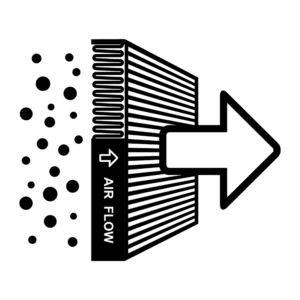 As we said earlier, each air filtration process and technology will work in specific mechanisms to accomplish this air filtration in the environment, and the carbon technology will contain a particular method of filtering the indoor air. Carbon air filters will work through absorption of pollutants onto a large surface area found on this carbon technology. The technology will pull pollutants into the mesh of the filter media and trap it within the filter in an effort to accomplish a filtering of the indoor environment’s air.
As we said earlier, each air filtration process and technology will work in specific mechanisms to accomplish this air filtration in the environment, and the carbon technology will contain a particular method of filtering the indoor air. Carbon air filters will work through absorption of pollutants onto a large surface area found on this carbon technology. The technology will pull pollutants into the mesh of the filter media and trap it within the filter in an effort to accomplish a filtering of the indoor environment’s air.
Additionally, often times a carbon air filter will be impregnated with chemical additives like silver, potassium permanganate, and other substances that will ultimately provide the filter with a better performance – allowing it to trap more pollutants onto the filter media overtime. Also, potassium permanganate will help the carbon filter to remove a broader range of chemical gases from the air due to its chemical reactivity with these gaseous pollutants when they come into contact on the carbon filter.
Are Carbon Air Filters Safe?
With the broad range of different air filter materials and technology provided to consumers, the carbon air filter is one of the more popular options for those individuals that are looking to effectively contain and capture a number of different types of airborne pollutants from the indoor air. Carbon air filters are known to be a very simple air filter technology that is also efficient, two characteristics that most Customers look for when purchasing air filters for their home. However, what if you learned that some of the essential features and functions of carbon air filters were unsafe to your environment and potentially to your health?
Although carbon air filters work by absorbing the pollutants in the air onto the large surface area of the filter media, helping to minimize pollutants in the indoor air of the environment- these pollutants can potentially start to re-release off the carbon filter as it becomes completely saturated and full on the filter media. It may be surprising to hear, but carbon air filters fill up by weight and often times these filters will fill up really quickly in the environment which will end up contributing to the re-releasing of chemicals and pollutants back into the indoor air which can have significant effects on the health of those that are exposed to these pollutants. In addition, carbon air filters also do not have the capability to trap and filter out dust, dust mites, and other pollutants that are considered fine particulate matter, and thus these pollutants can accumulate over time in the indoor air space.
How Long Do Carbon Filters Last?
 Something that is difficult to determine in most air purifiers is how long of a life the filters contained in the air purifier will last, which will depend on several conditions in the indoor environment. Carbon air filters particularly are filters that’s life will depend on a variety of factors in the indoor environment such as how large the environment is, the levels of pollutants in the space, and how many pounds of carbon are present on the carbon filter that is being utilized in either an air purifier or the air handling system in this indoor environment. According to the Environmental Protection Agency (EPA), activated carbon filters can be an effective air filter when large amounts of carbon material are used in the filter.
Something that is difficult to determine in most air purifiers is how long of a life the filters contained in the air purifier will last, which will depend on several conditions in the indoor environment. Carbon air filters particularly are filters that’s life will depend on a variety of factors in the indoor environment such as how large the environment is, the levels of pollutants in the space, and how many pounds of carbon are present on the carbon filter that is being utilized in either an air purifier or the air handling system in this indoor environment. According to the Environmental Protection Agency (EPA), activated carbon filters can be an effective air filter when large amounts of carbon material are used in the filter.
Typically, carbon air filters will last for a shorter duration of time when less carbon is used in the filter material. It is important to stay on-top of the filter replacement changes, especially when using carbon air filters because as we said earlier it can begin to re-release chemicals back into the indoor air creating recontamination in the air space.
What Does Carbon Filter Remove from the Air?
One important thing to look into before purchasing an air purifier is to determine what kind of pollutants are filtered out and removed from the air by each air filtration technology. The carbon filtration technology has been known to filter out a broad spectrum of airborne pollutants from the air – and this will even depend on what doping chemicals are utilized on the carbon filter as well. Carbon is known to work great against organic chemicals (gases) from the air and contain them on the filter of the carbon media. In addition, this type of filter will also help to alleviate odors from the air that are created from these various gaseous chemicals in the air space.
Air Purifier Technology Comparison
When it comes to air purifier technologies there are multiple different types that can be used in these air cleaning devices. Each technology will work in a specific manner to filter the indoor air – whether that be through ionization, ozone, HEPA filtration, or the carbon technology. Some of these technologies will create byproducts into the air while others will strictly use a filter media to capture and contain pollutants.
Below we are going to compare the different top air purifier technologies and how they work to filter the indoor air.
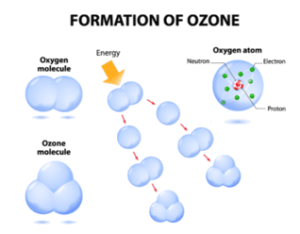 Ozone: An ozone generator or machine is a powerful oxidizer that is known to be effective against certain airborne contaminants like chemicals, smoke, and odors. These ozone producing machines contain several different risk factors in an indoor environment, especially an inhabited environment that can accumulate high levels of ozone in the air space. Ozone has been found to be a harmful byproduct to your lungs and can result in adverse health symptoms to those with preexisting conditions.
Ozone: An ozone generator or machine is a powerful oxidizer that is known to be effective against certain airborne contaminants like chemicals, smoke, and odors. These ozone producing machines contain several different risk factors in an indoor environment, especially an inhabited environment that can accumulate high levels of ozone in the air space. Ozone has been found to be a harmful byproduct to your lungs and can result in adverse health symptoms to those with preexisting conditions.- Ionizers: Air ionizers are air purification devices that produce negative ions into the air in an effort to clean the air of particulates like dust, dander, and pollen. The negative ions work by attracting the pollutants until it forms a large particle that will become weighted down and land on the surfaces inside the environment. However, ionization technology does have its downfalls as some of these air purifiers will produce ozone byproducts into the air that can be compromising to both the indoor air quality and the health of those occupants exposed to these airborne byproducts.
- HEPA: A HEPA filter is a great choice for those people who want to clean their air of particulate matter in the air, even those small fine particulate matters that are hard to contain and trap onto a filter media. The HEPA filter can remove 99.99 percent of particles from the air that are larger than 0.3 microns in size, making it a perfect go-to air filtration technology for particulate removal. However, when it comes to chemical and odor removal, HEPA filters will not be the best choice as it will do little to combat these airborne pollutants.
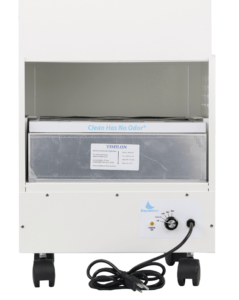 EnviroKlenz® Patented Technology: The EnviroKlenz® proprietary technology is composed of safe, non-toxic earth minerals that work to effectively to capture, contain, and neutralize a broad spectrum of noxious and toxic chemicals and odors from an indoor environment. In addition to chemical and odor neutralization within the EnviroKlenz Air Cartridge (1st stage of filtration in EnviroKlenz Air Purifier), there is also a 2nd stage filtration within this air purifier that utilizes a hospital-grade HEPA filter for fine particulate removal larger than 0.3 microns in size at a 99.99 percent efficiency. Thus, the EnviroKlenz technology and EnviroKlenz Air Purifier is a well-rounded, safe, and effective choice for broad spectrum neutralization that is completely removed from your indoor environment.
EnviroKlenz® Patented Technology: The EnviroKlenz® proprietary technology is composed of safe, non-toxic earth minerals that work to effectively to capture, contain, and neutralize a broad spectrum of noxious and toxic chemicals and odors from an indoor environment. In addition to chemical and odor neutralization within the EnviroKlenz Air Cartridge (1st stage of filtration in EnviroKlenz Air Purifier), there is also a 2nd stage filtration within this air purifier that utilizes a hospital-grade HEPA filter for fine particulate removal larger than 0.3 microns in size at a 99.99 percent efficiency. Thus, the EnviroKlenz technology and EnviroKlenz Air Purifier is a well-rounded, safe, and effective choice for broad spectrum neutralization that is completely removed from your indoor environment.
Article Sources:
- Penn State University (PSU): Activated Carbon (Charcoal) Filters (link)
- WebMD: Activated Charcoal (link)
- Environmental Protection Agency (EPA): Guide to Air Cleaners in the Home (link)
Mobile Air System
✓ Patented earth mineral technology works to attack VOCs and break them down on a compound level
✓ No chemicals or masking agents
✓ Will not release any chemicals back into your environment
✓ Safer and faster at removing VOC’s than traditional carbon filters and PECO air purifiers








